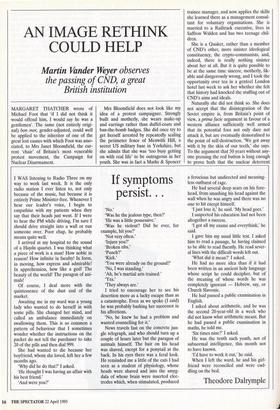AN IMAGE RETHINK COULD HELP
Martin Vander Weyer observes
the passing of CND, a great British institution
MARGARET THATCHER wrote of Michael Foot that 'if I did not think it would offend him, I would say he was a gentlemen'. The same (not entirely origi- nal) bon mot, gender-adjusted, could well be applied to the inheritor of one of the great lost causes with which Foot was asso- ciated, to Mrs Janet Bloomfield, the cur- rent 'chair' of Britain's most venerable protest movement, the Campaign for Nuclear Disarmament. Mrs Bloomfield does not look like my idea of a protest campaigner. Strongly built and motherly, she wears make-up and earrings rather than duffel-coats and ban-the-bomb badges. She did once try to get herself arrested by repeatedly scaling the perimeter fence of Menwith Hill, a secret US military base in Yorkshire, but she admits that she was `too busy getting on with real life' to be outrageous in her youth. She was in fact a Marks & Spencer trainee manager, and now applies the skills she learned there as a management consul- tant for voluntary organisations. She is married to a Railtrack executive, lives in Saffron Walden and has two teenage chil- dren.
She is a Quaker, rather than a member of CND's other, more sinister ideological constituency, the crypto-communists, and, indeed, there is really nothing sinister about her at all. But it is quite possible to be at the same time sincere, motherly, lik- able and dangerously wrong, and I took the opportunity over tea in a genteel London hotel last week to ask her whether she felt that history had knocked the stuffing out of CND's aims and ideals.
Naturally she did not think so. She does not accept that the disintegration of the Soviet empire is, from Britain's point of view, a prima facie argument in favour of a western alliance sufficiently well armed that its potential foes not only dare not attack it, but are eventually demoralised to the point of self-destruction. 'We got away with it by the skin of our teeth,' she says. To the argument that 50 years without any- one pressing the red button is long enough to prove both that the nuclear deterrent works and that it is capable of being man- aged safely, she offers the image of a man who throws himself off the top of a 40- storey building. As he passes the 22nd floor, he can be heard shouting, 'So far so good.'
Armed with this metaphor, she was en route to New York to address an interna- tional citizen's assembly in the margins of the Non-Proliferation Treaty conference, a meeting of 175 nations to discuss an exten- sion of the 25-year-old UN treaty under which non-nuclear states affirm their intention to stay that way. CND, in concert with the Non-Aligned Movement of small- er nations, wants an extension of the NPT conditional upon progress towards disar- mament by the five powerful countries, including Britain, which have had nuclear weapons since the first treaty was signed; the nuclear states, needless to say, are arguing for an indefinite extension of the treaty with no such condition.
All the world's nuclear pressure groups will be having their say at the conference, but does anyone else really care what CND wants any more? You certainly would not think so if you asked the Labour Party, with which CND was for so many years hand-in-glove. A spokesman for the shad- ow defence minister Dr David Clark said casually, 'CND? Are they still going?' There is, he says, no contact, and no CND input on Labour policy. Robin Cook, a prominent disarmament activist in days of old, has been trying to make Labour's atti- tude to the NPT talks sound respectably radical, but in practice he says that Britain should hang on to all 192 of its nuclear warheads until multilateral reductions become a reality.
CND's fading clout was evident in other ways this weekend. In a pale echo of East- er ban-the-bomb rallies of yesteryear, rep- resentatives of Youth CND marched on Easter Monday from Aldermaston to Lon- don, laying a wreath at the Cenotaph to mark the opening of the NPT conference. Original Aldermaston walkers, veterans of the first rally on Good Friday 1958, had been invited to join the ceremonies. But this dignified demonstration was upstaged entirely in national news bulletins by the Younger, bolder, sexier, environmentalist group, Greenpeace, mounting rival protests which involved blocking a nuclear waste pipe at Aldermaston and a mass storming of the gates of the Sellafield reprocessing plant. CND may have become dignified and middle-aged (well almost — it also plans a day of action at Sellafield shortly: 'bring padlocks, chains, paint' the leaflet says). But it still has a significant following and a valuable brand-name. It claims a member- ship of about 50,000, down from a peak of 110,000 in 1984 when argument was raging over Trident and Cruise, but many times the number at its nadir in the late 1970s. Its logo — that Mercedes-Benz badge with the extra vertical stroke, which adorned two generations of anoraks and headbands — would probably be recognised by every British adult over the age of 30. But does CND still have a product to sell?
According to its detractors, the move- ment was so tainted by its native pro-Sovi- et bias that it can never regain the purity of principle with which its founders Canon Collins, Bertrand Russell et al began. But as far as Bloomfield is con- cerned, all that was in the past, and a bit of a sideshow. It is true that in the lean period of the 1970s CND was helped to stay alive by funds from the Communist Party of Great Britain, which we now know was in turn funded by Moscow. In the early 1980s Bloomfield's predecessors, the former Catholic priest Bruce Kent and the current Labour MP Joan Ruddock, were always quick to criticise Reagan and Thatcher but slow to object to the deploy- ment of Russian SS-20s. Oleg Gordievsky has said that all unilateral disarmers were in effect communist dupes, even if they resisted direct blandishments from the KGB. As late as 1990, CND appointed an • undisguised Stalinist, Gary Lefley, as its salaried general secretary.
All that is gone now: Lefley went the way of all Stalinist idols, and heavy leftism no longer drives the organisation. Still, banning the bomb is now a lost cause. Per- haps that is why Bloomfield believes the next phase of CND's existence will focus on wider, fuzzier issues, 'which link envi- ronment, development and peace — all kinds of disarmament causes, in more interesting, variegated shapes' including, as CND's revised constitution puts it, 'the transfer of military resources to meet real human need'. There is, according to Bloom- field, a community of interest between a range of 1990s protest movements, whether they are concerned with disarmament, the export of live animals or the routing of by- passes. They are all concerned with 'quality of life issues' (a consumerist phrase) and 'the human relationship with the planet'. They are all also, of course, causes which appeal to a natural youthful instinct to distrust the Establishment and climb over its fences. But can CND generate enough excitement for its younger members to keep them interested, when Greenpeace and the Criminal Justice Act objectors seem to have so much more fun?
Perhaps in the end, CND will become part of the heritage industry, like the Durham Miners' Gala and the state open- ing of Parliament. Latge country houses are obsolete. They have been saved — why not CND? An image rethink could help, a change of name to something more soft- focused like Relate or Unison, or adverts based on the current Cornflakes campaign, in which middle-aged people would be overcome with warm nostalgia at the sight of the symbol which means ban the bomb.



























































 Previous page
Previous page